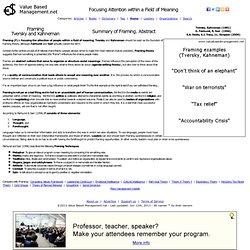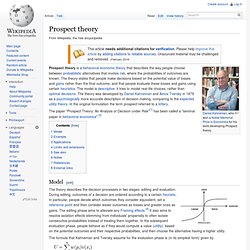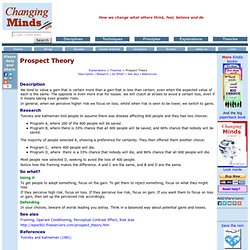

Framing - Mozilla Firefox. Framing. Explanations > Theories > Framing Description | Research | Example | So What?

| See also | References Description A frame is the combination of beliefs, values, attitudes, mental models, and so on which we use to perceive a situation. We effectively look through this frame in the way we would look through tinted spectacles. Kahneman and Tversky defined a decision frame as ‘the decision-maker’s conception of the act, outcomes and contingencies associated with a particular choice.’ Research Tversky and Kahneman offered people one of the following choices: A: A sure gain of $240 B: A 25% chance to gain $1000 and 75% chance of getting nothing. 84% of people chose the more certain A. C: A sure loss of 750 D: A 75% chance of losing $1000 and a 25% chance to lose nothing. Now 73% preferred to gamble. The framing of the question in each case was important, as B and D actually have higher expected utility (value) than A and C.
Example I see a holiday in the hills as a opportunity for outdoor exercise. Framing explained. Framing (F) is focusing the attention of people within a field of meaning.

Tversky and Kahneman should be seen as the founders of framing theory, although Fairhurst and Sarr actually coined the term. Contrary to the central concept of of rational choice theory (people always strive to make the most rational choices possible), Framing theory suggests that how something is presented (the “frame”) influences the choices people make. Framing (economics) In the social sciences, framing is a set of concepts and theoretical perspectives on how individuals, groups, and societies organize, perceive, and communicate about reality.

Framing is the social construction of a social phenomenon often by mass media sources, political or social movements, political leaders, or other actors and organizations. It is an inevitable process of selective influence over the individual's perception of the meanings attributed to words or phrases. It is generally considered in one of two ways: as frames in thought, consisting of the mental representations, interpretations, and simplifications of reality, and frames in communication, consisting of the communication of frames between different actors.[1] The effects of framing can be seen in many journalism applications. With the same information being used as a base, the ‘frame’ surrounding the issue can change the reader’s perception without having to alter the actual facts. Trends. Loss Aversion. Regret. Mental Accounting. Prospect Theory. Cumulative Prospect Theory Calculator. Prospect theory. The paper "Prospect Theory: An Analysis of Decision under Risk"[1] has been called a "seminal paper in behavioral economics".[2] Model[edit] The formula that Kahneman and Tversky assume for the evaluation phase is (in its simplest form) given by where is the overall or expected utility of the outcomes to the individual making the decision, are the potential outcomes and their respective probabilities. is a function that assigns a value to an outcome.

Is a probability weighting function and captures the idea that people tend to overreact to small probability events, but under react to large probabilities. Example[edit] To see how Prospect Theory can be applied, consider the decision to buy insurance. 1. 2. These expressions can be computed numerically. In losses, and hence the insurance looks unattractive. Kahneman and Tversky's Prospect Theory. Prospect Theory. Explanations > Theories > Prospect Theory Description | Research | So What?

| See also | References Description We tend to value a gain that is certain more than a gain that is less than certain, even when the expected value of each is the same. The opposite is even more true for losses: we will clutch at straws to avoid a certain loss, even if it means taking even greater risks. In general, when we perceive higher risk we focus on loss, whilst when risk is seen to be lower, we switch to gains.
Research Tversky and Kahneman told people to assume there was disease affecting 600 people and they had two choices: Program A, where 200 of the 600 people will be saved . The majority of people selected A, showing a preference for certainty. Program C, where 400 people will die. Most people now selected D, seeking to avoid the loss of 400 people. Certainty Effect. Regret. Mental Accounting.